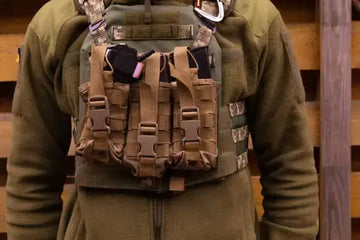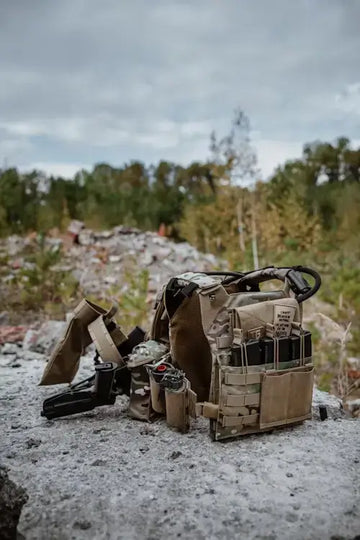Level 3 Body Armor: What You Need to Know Before Buying
بواسطة QiuQingyun على Nov 11, 2024

Body armor is essential for people who need reliable protection in dangerous situations.
Among the different levels, Level 3 body armor stands out as a strong option for stopping rifle rounds.
Whether you’re in law enforcement, security, or simply a civilian who wants added protection, Level 3 armor offers a balance of security and practicality.
Let’s dive into what makes Level 3 body armor unique, why people choose it, and what you should know before making a purchase.
1. What Is Level 3 Body Armor?
Level 3 body armor is designed to protect against rifle rounds. According to NIJ (National Institute of Justice) standards, Level 3 armor can stop rifle bullets like the .308 Winchester FMJ.
This is a major step up from Level 2, which generally only stops handgun rounds.
If you’re looking for armor that can handle a wider range of threats, Level 3 is where serious protection begins.
While it provides solid defense, it’s important to note that Level 3 armor isn’t typically rated for armor-piercing rounds. For those, Level 4 body armor may be needed.
2. Materials and Construction
Level 3 body armor can be made from a few different materials.
The choice of material affects the weight, flexibility, and durability of the armor.
- Steel Plates – Known for their durability and strength, steel plates are reliable but tend to be heavier. Steel can handle multiple impacts but may cause “spalling,” where fragments scatter on impact.
- Ceramic Plates – These plates are lighter than steel and are designed to break on impact to absorb the bullet’s energy. Ceramic plates are popular due to their lighter weight but may crack after a hard hit, limiting their reusability.
- UHMWPE (Ultra-High Molecular Weight Polyethylene) – This is a type of hard plastic that’s very lightweight yet strong. UHMWPE armor is easy to carry, but it’s often more expensive.
Each material has its pros and cons, so it’s important to consider what’s most important to you—whether that’s weight, cost, or reusability.
3. Applications and Who Uses It
Level 3 body armor is widely used by professionals and civilians alike. Here are a few groups that often choose this level of armor:
- Law Enforcement Officers – Level 3 armor provides police officers with extra protection against firearms they might encounter in the field.
- Security Personnel – Security guards, especially those in high-risk areas, may wear Level 3 armor for added safety.
- Military Personnel – Soldiers may use Level 3 plates in combination with other armor for additional coverage.
- Prepared Civilians – Some civilians buy Level 3 armor for personal protection, particularly in areas where higher-caliber threats are a concern.
4. Pros and Cons of Level 3 Body Armor
As with any protective gear, Level 3 armor has both advantages and limitations. Here’s a quick breakdown to help you decide if it’s right for you.
Pros
- Protection Against Rifle Rounds – Level 3 body armor is effective against many common rifle rounds.
- Durable Construction – Materials like steel and ceramic offer reliable protection, even in rough conditions.
- Widely Available – Level 3 is a standard level, so you’ll find many options to choose from.
Cons
- Heavier than Lower Levels – Level 3 armor is bulkier and heavier than Level 2, which can make it tiring to wear for long periods.
- May Not Stop Armor-Piercing Rounds – Level 3 doesn’t cover armor-piercing bullets; Level 4 is better for those threats.
- Limited Flexibility – While Level 3 offers strong protection, it’s often stiffer than soft armor, limiting mobility somewhat.
5. Types of Level 3 Body Armor
Level 3 body armor comes in different forms, each suited to different needs. Here’s a look at the main types you might encounter:
- Standalone Plates – These plates are meant to work on their own, offering full Level 3 protection without needing extra layers.
- In-Conjunction Plates – These plates require an additional layer of soft armor to achieve Level 3 protection. They’re often lighter but rely on a combination of materials to stop bullets.
- Plate Carriers – Plate carriers hold the protective plates and are designed for easy wear. A carrier can be customized with additional pouches and accessories to suit different tactical needs.
6. Choosing the Right Level 3 Body Armor
If you’ve decided that Level 3 body armor is what you need, there are a few factors to consider before buying:
- Weight – Steel plates are heavier, while UHMWPE is very light. Choose the weight that’s most comfortable for your intended use.
- Cost – Ceramic and UHMWPE plates can be pricey, so set a budget and explore your options.
- Fit and Comfort – Make sure the armor fits your body well. An ill-fitting plate can be uncomfortable and limit your range of motion.
- Reusability – If you plan on reusing the armor, steel might be a better choice. Ceramic may need replacement after a single impact.
7. Maintenance and Care
Keeping your Level 3 body armor in top condition is essential for maintaining its effectiveness. Here are some simple care tips:
- Storage – Store the armor in a cool, dry place. Avoid direct sunlight, as this can weaken certain materials over time.
- Cleaning – Wipe the armor with a damp cloth and mild soap. Avoid harsh chemicals that can damage the surface.
- Regular Inspection – Check for cracks or signs of wear, especially if the armor has been exposed to impacts. Replace damaged plates immediately.
Following these care tips will help extend the life of your armor and keep it ready for when you need it.
8. Legal Considerations
Laws surrounding body armor vary, especially for civilians. Some places require permits or restrict who can own certain types of armor.
Before buying, make sure you’re aware of any legal restrictions in your area.
For example, in Australia, civilians cannot legally buy or possess body armor without a permit, as it’s considered a prohibited item in most states.
Similarly, in the United States, the state of Connecticut requires buyers to purchase body armor in person, prohibiting online sales to civilians.
In some countries, like the UK, while body armor is generally legal to own, wearing it with criminal intent can lead to legal repercussions.
Always check local regulations to ensure compliance before purchasing body armor.
9. Future of Level 3 Body Armor
The future of Level 3 body armor is promising, with new technology making it lighter, stronger, and more comfortable.
Researchers are looking at new materials, like graphene and carbon nanotubes, which are very strong but much lighter than traditional steel or ceramic.
This means that in the future, armor could provide the same protection with less weight, making it easier to move around and less tiring to wear.
Some companies are also working on flexible armor designs. These combine soft layers with lightweight hard plates to protect against rifles without being too bulky.
This hybrid style could be great for people who need full protection but also need to move easily.
Another big improvement is in the way armor is made. With new 3D printing techniques, companies can create armor that fits the body more closely.
This makes it more comfortable to wear and gives better coverage, especially in high-risk situations where a snug fit is important.
For buyers, these changes mean that future Level 3 body armor will likely offer better protection without the drawbacks of extra weight or discomfort.
As manufacturing improves, this high-quality armor could become more affordable and available to a wider range of people, from police officers to civilians who want reliable protection.
Conclusion
Level 3 body armor is a solid choice for anyone looking for reliable rifle protection. By understanding the materials, applications, and limitations of Level 3 armor, you’ll be better equipped to choose the right protection for your needs.
And remember, keeping it in good condition and knowing the laws surrounding its use will ensure you’re prepared for any situation.
Related FAQs
1. Can Level 3 body armor stop an AR-15 round?
Yes, Level 3 armor is rated to stop most AR-15 rounds. However, it may not stop all armor-piercing rounds fired from this type of rifle.
2. What’s the difference between Level 3 and Level 3+?
Level 3+ is an unofficial rating that indicates added protection. Level 3+ armor often stops more types of rifle rounds but may not be NIJ-certified.
3. Is Level 3 armor suitable for daily wear?
For most people, Level 3 armor is too bulky for daily wear. It’s more suited for high-risk situations where rifle protection is necessary.
4. Is body armor good for you?
Body armor can be beneficial if you need protection in high-risk situations, such as in law enforcement or security roles. It provides an extra layer of safety against bullets or other threats, which can save lives.
However, body armor can be heavy and uncomfortable for long periods, and it isn't necessary for everyday activities. For most people, body armor is only practical if their job or environment involves significant risk.





